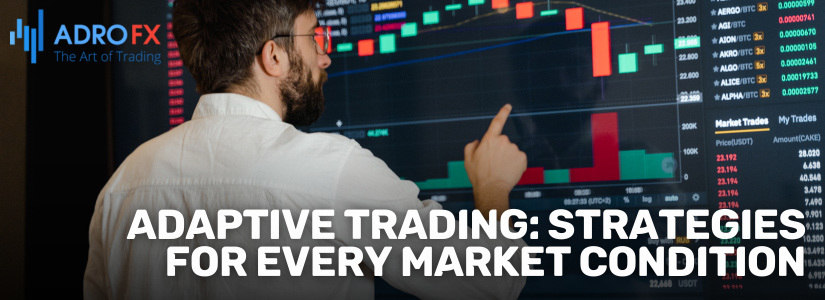Adaptive Trading: Strategies for Every Market Condition

Understanding "market conditions" is a pivotal aspect of navigating the complex landscape of financial markets. At its core, market conditions encapsulate the intricate web of factors shaping the overall state and behavior of a financial market at any given point in time. This dynamic concept is influenced by an array of elements, including supply and demand dynamics, economic indicators, investor sentiment, geopolitical events, and regulatory changes. In essence, comprehending market conditions is more than a skill; it's a strategic imperative for investors and traders alike. This article delves into the multifaceted dimensions of market conditions, unraveling key aspects and exploring the diverse types that characterize the financial realm.
Market Condition Explained
"Market conditions" refer to the overall state and characteristics of a financial market at a specific point in time. These conditions are influenced by various factors, including supply and demand dynamics, economic indicators, investor sentiment, geopolitical events, and regulatory changes. Understanding market conditions is crucial for investors and traders as it helps them assess potential risks and opportunities.
Key aspects of market conditions include:
- Volatility
The degree of variation in trading prices over time. High volatility often indicates greater uncertainty and risk. - Trends
The direction in which prices are moving over a certain period. Markets can be in an uptrend, downtrend, or range-bound. - Liquidity
The ease with which assets can be bought or sold in the market without affecting their prices significantly. - Interest Rates
Central bank policies and interest rate changes can impact borrowing costs, spending, and investment decisions. - Economic Indicators
Data such as GDP growth, employment figures, inflation rates, and consumer confidence can influence market conditions. - Market Sentiment
The overall feeling or attitude of investors toward the market. Positive sentiment can drive buying, while negative sentiment may lead to selling. - Geopolitical Events
Political instability, trade tensions, and global conflicts can introduce uncertainty and affect market conditions. - Regulatory Changes
Alterations in financial regulations or policies can impact market behavior and participant activities. - Earnings Reports
The financial performance of companies, as reflected in earnings reports, can influence stock market conditions. - Market Breadth
The number of advancing stocks versus declining stocks can provide insights into the overall health of a market.
Analyzing market conditions helps investors make informed decisions about asset allocation, risk management, and market participation. Traders often use technical analysis, fundamental analysis, and a combination of both to assess and respond to prevailing market conditions.

Types of Market Conditions
Financial markets showcase a variety of conditions, each marked by distinct characteristics and behaviors. Traders and investors analyze these conditions to make informed decisions. Some common types of market conditions include:
Bull Market:
In a bull market, prices rise, optimism prevails, and confidence increases. Buyers dominate, expecting further price increases. Strategies often involve buy-and-hold and trend-following approaches.
Bear Market:
A bear market is characterized by falling prices, pessimism, and declining confidence. Sellers dominate, anticipating further declines. Strategies may involve short-selling, defensive approaches, and risk aversion.
Sideways or Range-Bound Market:
This condition sees prices moving within a relatively narrow range, lacking a clear trend. Investors exhibit uncertainty and indecision, with balanced buying and selling. Strategies include range trading and adopting trend-following approaches during breakouts.
Volatile Market:
In a volatile market, prices experience sharp fluctuations and rapid, unpredictable movements. Investors navigate heightened uncertainty, exercising caution and engaging in short-term trading. Strategies often revolve around risk management, options trading, and volatility-based approaches.
Calm or Quiet Market:
A calm or quiet market is characterized by low volatility, stable prices, and subdued trading activity. Investors experience low anxiety, potential boredom, and may opt for longer-term investments. Strategies may involve income-generating approaches and buy-and-hold strategies.
Bullish Trend Reversal:
This condition signifies a shift from a bear market to a bullish trend. Investors gradually transition from selling to buying. Strategies involve identifying early signs of reversal and trend-following.
Bearish Trend Reversal:
A bearish trend reversal indicates a move from a bull market to a bearish trend. Investors gradually shift from buying to selling. Strategies focus on identifying early signs of reversal and adopting defensive approaches.
Crash or Panic Market:
A crash or panic market is marked by a sharp and sudden decline, leading to widespread selling. Investors experience fear, panic selling, and a rush to liquidate positions. Strategies revolve around defensive approaches, risk management, and seeking safe-haven assets.
Recovery or Bottoming Out:
In a recovery or bottoming-out scenario, the market shows signs of stabilization after a prolonged decline. Investors witness a gradual return of confidence and engage in bargain hunting. Strategies involve value investing and identifying potential turnaround opportunities.
Irrational Exuberance:
Irrational exuberance is characterized by excessive optimism and speculative buying. Investors display overconfidence and may disregard risks. Strategies focus on caution, risk management, and avoiding excessive speculation.
Understanding prevailing market conditions helps investors and traders align their strategies with the current environment, enhancing the likelihood of successful decision-making. It's important to note that market conditions are dynamic and can change over time.

How to Identify Market Conditions
Identifying market conditions involves a nuanced understanding of the broader financial landscape. Observing the price movements, trends, and overall sentiment in the market provides valuable insights. Traders and investors often rely on qualitative and quantitative analysis to discern prevailing conditions.
Analyzing price trends is a fundamental aspect of market condition identification. A sustained uptrend may indicate a bullish market, while a prolonged downtrend suggests a bearish sentiment. Sideways movements without clear trends may signify a range-bound or consolidating market.
Monitoring trading volumes offers additional cues. High trading volumes during price increases or decreases can indicate the strength of a trend. Low volumes during a range-bound period may suggest indecision or a lack of conviction among market participants.
Sentiment analysis involves gauging the overall mood of investors. Positive news, economic indicators, or corporate earnings reports may contribute to bullish sentiment, while negative news can lead to bearish sentiment. Social media, financial news, and market commentaries are sources for assessing sentiment.
Volatility observation is crucial for identifying market conditions. Elevated volatility often characterizes uncertain or turbulent periods, indicating potential opportunities for short-term traders. Conversely, low volatility may suggest stability or a quiet market.
Recognizing key support and resistance levels helps determine potential turning points in the market. Breakouts from these levels can signal shifts in sentiment. Traders often use technical analysis to identify these critical price levels.
Macroeconomic indicators contribute to the understanding of market conditions. Factors like interest rates, inflation, and economic growth impact overall market sentiment. Monitoring these indicators provides a broader context for market analysis.
While individual indicators offer insights, combining multiple signals enhances the accuracy of market condition identification. Traders and investors often use a holistic approach, considering a combination of technical, fundamental, and sentiment analysis to form a comprehensive view of prevailing market conditions. Continuous monitoring and adaptation to evolving circumstances are crucial in navigating dynamic financial markets.
What Can Change Market Conditions
Market conditions are shaped by a multitude of elements, making them dynamic and ever-changing. These shifts are often influenced by changes in economic indicators, which are metrics reflecting the health and performance of a country's economy. Geopolitical events, such as political unrest or trade tensions between nations, can introduce uncertainties, causing market fluctuations. Monetary policies set by central banks also play a crucial role; decisions regarding interest rates affect borrowing costs and investor behavior.
The global landscape is prone to unexpected events, like natural disasters or public health crises, which can swiftly impact market sentiment. Additionally, technological advancements and shifts in consumer preferences can alter the demand for certain products or industries, affecting market conditions.
Investor behavior, characterized by buying or selling decisions, further contributes to market dynamics. Furthermore, corporate earnings reports, indicating a company's financial health and regulatory changes can significantly influence stock prices. Industry trends, reflecting the performance of specific sectors, contribute to the overall market environment.
The interplay of these factors creates an intricate web of influences on market conditions. For instance, positive economic indicators and favorable geopolitical developments can create a bullish market, characterized by rising prices. Conversely, negative news or economic downturns can lead to bearish markets, marked by falling prices.
Understanding these dynamics is crucial for investors as it helps inform strategic decisions. A comprehensive analysis of market conditions involves considering these diverse elements, their potential impacts, and the broader economic context. By staying informed about these factors, investors can navigate the complexities of the financial landscape more effectively and make well-informed investment decisions.

Trading in All Market Conditions
Successfully trading in all market conditions requires a versatile approach that adapts to various scenarios. Here are strategies and tips to navigate different market conditions:
- Understand Market Conditions
Gain a comprehensive understanding of different market conditions, including bullish, bearish, and ranging markets. Each condition requires a specific strategy, and recognizing the prevailing environment is the first step.
- Diversification
Diversify your trading portfolio across different asset classes, industries, or sectors. This helps spread risk and minimizes the impact of poor performance in a specific area.
- Trend Following in Bullish Markets
In a bullish market, identify and follow the trend. Utilize technical analysis tools to spot upward trends, and consider trend-following strategies such as moving averages or momentum indicators.
- Short Selling in Bearish Markets
In a bearish market, take advantage of declining prices by employing short-selling strategies. This involves selling assets you don't own to buy them back at a lower price later.
- Range-Bound Strategies
During periods of market consolidation or ranging conditions, focus on range-bound strategies. Identify support and resistance levels and trade within those boundaries using strategies like mean reversion.
- Volatility Trading
In volatile markets, implement strategies designed to capitalize on price fluctuations. This could include options trading, volatility indices, or strategies that benefit from heightened market movements.
- Risk Management
Regardless of market conditions, prioritize risk management. Set clear Stop Loss orders, diversify your positions, and only risk a small percentage of your trading capital on each trade.
- Stay Informed
Keep abreast of economic indicators, news, and events that could impact the markets. Stay informed about global economic trends and geopolitical developments that may influence asset prices.
- Adaptability
Markets can change rapidly. Be adaptable and willing to adjust your strategies based on evolving conditions. What works in one market may not be effective in another.
- Continuous Learning
Stay committed to continuous learning. Markets evolve, and staying informed about new trading strategies, tools, and market dynamics is essential for long-term success.
- Emotional Discipline
Emotional discipline is crucial in all market conditions. Avoid making impulsive decisions based on fear or greed. Stick to your trading plan and strategy.
- Backtesting
Before implementing a strategy in live markets, backtest it using historical data. This helps evaluate the strategy's performance and refine it if necessary.
- Use Technology
Leverage technology and trading platforms to access real-time data, execute trades efficiently, and utilize advanced analytics for better decision-making.
Remember, no strategy guarantees success in all market conditions. A diversified and adaptive approach, coupled with risk management and continuous learning, increases your chances of navigating the complexities of various market environments.
Conclusion
In conclusion, the fluid nature of financial markets demands a nuanced understanding of market conditions. These conditions, influenced by an interplay of economic, geopolitical, and behavioral factors, are integral in assessing the ever-present risks and opportunities in the market. Whether it's navigating a bullish trend, preparing for a bearish downturn, or adapting to volatile scenarios, investors and traders benefit immensely from a holistic understanding of prevailing market conditions. As we navigate the dynamic landscape of financial markets, the ability to identify, comprehend, and respond to changing conditions emerges as a cornerstone for informed decision-making. In this journey, continuous learning, adaptability, and strategic discipline become indispensable companions, ensuring that market participants are well-equipped to thrive in the ever-evolving world of finance.
About AdroFx
Established in 2018, AdroFx is known for its high technology and its ability to deliver high-quality brokerage services in more than 200 countries around the world. AdroFx makes every effort to keep its customers satisfied and to meet all the trading needs of any trader. With the five types of trading accounts, we have all it takes to fit any traders` needs and styles. The company provides access to 115+ trading instruments, including currencies, metals, stocks, and cryptocurrencies, which make it possible to make the most out of trading on the financial markets. Considering all the above, AdroFx is the perfect variant for anyone who doesn't settle for less than the best.










